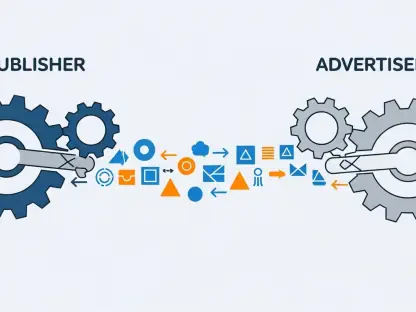In the ever-evolving landscape of cybersecurity, Fortinet Inc. has emerged as a formidable force, consistently delivering impressive financial results that signal its strength in a competitive market, even as its latest guidance raised concerns among investors. The company’s second-quarter performance was no exception, with earnings and revenue figures surpassing expectations and showcasing robust demand for its solutions. Yet, despite these achievements, a shadow of doubt has crept over investor sentiment, triggered by cautious guidance that hints at slower growth ahead. This unexpected reaction raises critical questions about the balance between current success and future expectations in the tech sector. While Fortinet’s fundamentals appear solid, the market’s response underscores the intense pressure on cybersecurity firms to project unwavering growth. This article aims to dissect the paradox of strong earnings juxtaposed against a sharp decline in share price, exploring the financial highlights, strategic initiatives, and broader industry dynamics that shape this narrative.
Financial Performance: A Strong Foundation
Earnings and Revenue Highlights
Fortinet’s financial results for the second quarter demonstrated a clear picture of resilience and profitability in a demanding industry. The company reported adjusted earnings of 64 cents per share, a notable improvement from the 57 cents recorded in the same period last year, and comfortably ahead of the 59 cents anticipated by analysts. Revenue also reflected strength, reaching $1.63 billion, which marked a 14% increase year-over-year and aligned precisely with market forecasts. Additionally, billings—a critical indicator of future revenue streams—climbed 15% to $1.78 billion, pointing to sustained customer engagement and demand for Fortinet’s offerings. These numbers not only highlight operational efficiency but also reinforce the company’s ability to capitalize on the growing need for robust cybersecurity measures across various sectors.
A deeper look into these results reveals the consistency of Fortinet’s performance amidst economic uncertainties that often challenge tech firms. The surpassing of earnings estimates suggests a well-executed strategy in managing costs while scaling operations. Revenue growth, paired with strong billings, indicates that Fortinet continues to attract and retain clients in a market where trust and reliability are paramount. This financial stability serves as a testament to the company’s solid footing, even as it navigates the complexities of a rapidly changing digital threat landscape. Such metrics provide a foundation of confidence, though they stand in stark contrast to the market’s reaction to future projections.
Growth in Key Metrics
Beyond the headline figures, Fortinet exhibited remarkable progress in metrics that signal long-term sustainability and customer commitment. Annual recurring revenue (ARR) streams showed significant growth, with a 22% increase in its unified security service edge (SASE) solution and an impressive 35% rise in security operations (SecOps) ARR. Total remaining performance obligations, which measure contracted future revenue, stood at $6.642 billion, up 12% from the previous year. These gains underscore Fortinet’s ability to secure enduring partnerships and build a predictable revenue base, a critical factor in an industry prone to volatility.
Equally important is how these metrics reflect Fortinet’s strategic alignment with emerging cybersecurity needs. The sharp growth in SASE and SecOps ARR indicates that clients are increasingly relying on Fortinet for comprehensive, integrated solutions that address complex threats in hybrid environments. The rise in remaining performance obligations further suggests that the company is not merely riding a wave of temporary demand but is establishing itself as a trusted provider for the foreseeable future. This depth of financial health paints a picture of a company poised for stability, yet it also sets a high bar for maintaining such momentum in the eyes of investors.
Strategic Moves and Innovation: Positioning for the Future
Product Expansion and Technological Edge
Fortinet’s commitment to staying ahead of the curve is evident in its strategic initiatives, particularly through the expansion of its product ecosystem. The enhancement of the FortiCloud platform with new services such as FortiIdentity, FortiDrive, and FortiConnect addresses the evolving needs of hybrid and remote-first enterprises. These offerings focus on identity management, secure content storage, and streamlined onboarding, respectively, ensuring that Fortinet remains relevant in a world where workplace dynamics are shifting. This adaptability showcases a proactive approach to market demands, strengthening the company’s competitive stance.
Innovation is another cornerstone of Fortinet’s strategy, as demonstrated by its achievement of over 1,400 globally issued patents, with more than 500 related to artificial intelligence either pending or approved. This extensive portfolio highlights a dedication to leveraging cutting-edge technology to tackle sophisticated cyber threats. By investing heavily in research and development, Fortinet not only enhances its current offerings but also builds a foundation for future advancements. Such efforts signal to the market that the company is not content to rest on past successes but is actively shaping the trajectory of cybersecurity solutions.
Industry Leadership and Recognition
Fortinet’s position as a market leader is further solidified by its recognition and strategic focus on critical areas like operational technology (OT) and information technology (IT) convergence. The company has been acknowledged for its capabilities in network protection for industrial and mission-critical environments, a growing concern as digital infrastructure becomes more interconnected. Additionally, its ranking in the Gartner Magic Quadrant for SASE Platforms underscores Fortinet’s prominence in delivering next-generation security solutions, affirming its relevance in a crowded field.
Leadership extends beyond accolades to tangible market presence, as noted by CEO Ken Xie, who emphasized the company’s customer-first philosophy and its status as the provider of the most deployed firewalls globally. This widespread adoption reflects trust in Fortinet’s ability to secure networks at scale, a crucial factor in an era of escalating cyber risks. By continuously refining its offerings and earning industry validation, Fortinet reinforces its role as a pacesetter, even as it faces the challenge of aligning such achievements with investor expectations for unrelenting growth.
Market Reaction: Guidance Sparks Concern
Cautious Projections
Despite a commendable quarterly performance, Fortinet’s forward-looking guidance introduced an element of caution that quickly shifted market perceptions. For the third quarter, the company projected adjusted earnings per share of 62 to 64 cents, marginally above the 61 cents expected by analysts. However, its revenue forecast of $1.67 billion to $1.73 billion fell slightly below the midpoint of $1.71 billion that the market had anticipated. Full-year projections also tempered enthusiasm, with adjusted earnings per share estimated at $2.47 to $2.53 and revenue between $6.675 billion and $6.825 billion, compared to analyst expectations of $2.49 per share and $6.76 billion. These figures, while not drastically off-target, lacked the aggressive growth signals investors often seek.
The cautious tone of this guidance suggests a pragmatic approach by Fortinet’s management, possibly reflecting broader economic uncertainties or internal assessments of market saturation in certain segments. This conservative outlook, though grounded in realistic planning, contrasts sharply with the high-growth narratives that tech investors typically favor. The absence of upward revisions or bold projections may indicate a strategic focus on stability over speculation, but it also risks being interpreted as a sign of waning momentum. This delicate balance between caution and ambition lies at the heart of the market’s unease.
Investor Sentiment and Share Price Drop
The market’s reaction to Fortinet’s guidance was both swift and severe, with the company’s shares plunging more than 16% in late trading following the earnings announcement. This significant drop illustrates the heightened sensitivity of investors to any hint of slowdown, particularly in a sector like cybersecurity where rapid expansion is often expected. Even though the guidance figures were not far from consensus estimates, the lack of a clear signal of accelerated growth appears to have triggered widespread concern about Fortinet’s ability to sustain its current trajectory.
This sharp decline in share price also reflects broader anxieties about the cybersecurity industry’s growth potential amidst competitive pressures and macroeconomic challenges. Investors seem to be weighing whether Fortinet’s cautious outlook is a company-specific issue or indicative of sector-wide headwinds. The dramatic market response underscores a critical dynamic in tech investments: the emphasis on future performance often overshadows present achievements. For Fortinet, this reaction serves as a reminder of the unrelenting demand for not just success, but exceptional forward-looking confidence to maintain market favor.
Industry Dynamics: High Stakes in Cybersecurity
Expectations Versus Reality
The cybersecurity sector operates under a unique set of expectations, where companies like Fortinet are held to extraordinarily high standards of growth and innovation. The market often demands not just consistent performance but continuous outperformance, driven by the critical role these firms play in protecting digital infrastructure. Fortinet’s solid quarterly results, while impressive, were quickly overshadowed by guidance that failed to project the aggressive expansion investors crave. This disparity highlights a fundamental tension in the industry: the need to balance operational excellence with ambitious forecasts that reassure stakeholders of future dominance.
This tension is compounded by the rapid pace of technological change and the escalating complexity of cyber threats, which require constant investment and adaptation. For Fortinet, meeting these challenges is non-negotiable, yet the market’s reaction suggests that operational wins alone are insufficient. Investors appear to prioritize signals of exponential growth over steady progress, creating a high-stakes environment where even minor deviations from expected trajectories can lead to significant repercussions. This dynamic poses a persistent challenge for cybersecurity leaders striving to align business strategies with market sentiment.
Future Implications and Strategic Considerations
Looking ahead, Fortinet’s experience sheds light on broader trends that will likely shape the cybersecurity landscape in the coming years. The intense focus on forward-looking guidance as a barometer of success indicates that companies must craft narratives of growth alongside their financial reports to maintain investor confidence. For Fortinet, this may involve clearer communication about strategic priorities or potential catalysts for future expansion, even within a cautious framework. The market’s volatility also suggests that cybersecurity firms need to brace for heightened scrutiny as economic uncertainties persist.
Strategically, Fortinet’s emphasis on innovation and market leadership positions it well to navigate these challenges, provided it can address investor concerns about growth momentum. Continued investment in areas like artificial intelligence and hybrid security solutions will be crucial, as will demonstrating adaptability to emerging threats. The broader implication for the industry is clear: success is no longer measured solely by current performance but by the promise of sustained, exceptional progress. Fortinet’s path forward will depend on balancing these dual imperatives to rebuild market trust.
Reflecting on Market Realities: Lessons Learned
Reflecting on Fortinet’s journey through the second quarter, it becomes evident that the company achieved remarkable financial and strategic milestones, from surpassing earnings expectations to expanding its innovative footprint. The robust growth in revenue, billings, and recurring streams, alongside advancements in product offerings, positioned Fortinet as a beacon of reliability in cybersecurity. Yet, the sharp decline in share price following cautious guidance revealed a critical vulnerability: the market’s unforgiving focus on future growth over present success. This episode serves as a stark reminder of the volatile nature of tech investments. Moving forward, a key consideration for Fortinet and similar firms will be to enhance transparency in communicating growth strategies, ensuring that solid fundamentals are not eclipsed by perceived shortfalls in ambition. By aligning operational achievements with compelling visions of the future, Fortinet can work to restore investor faith and navigate the high expectations of the cybersecurity arena.









